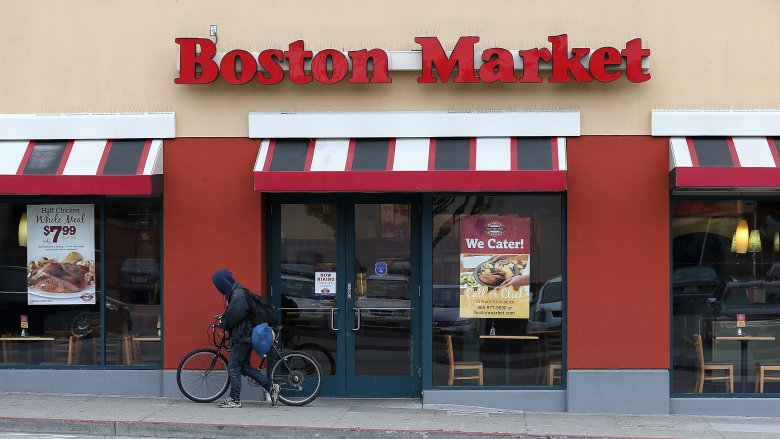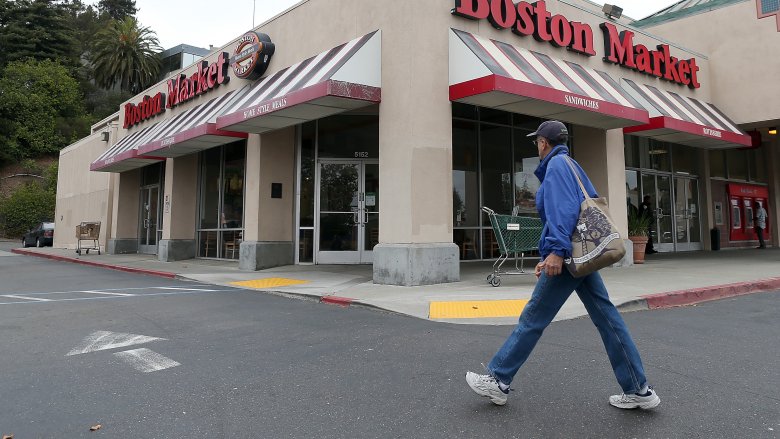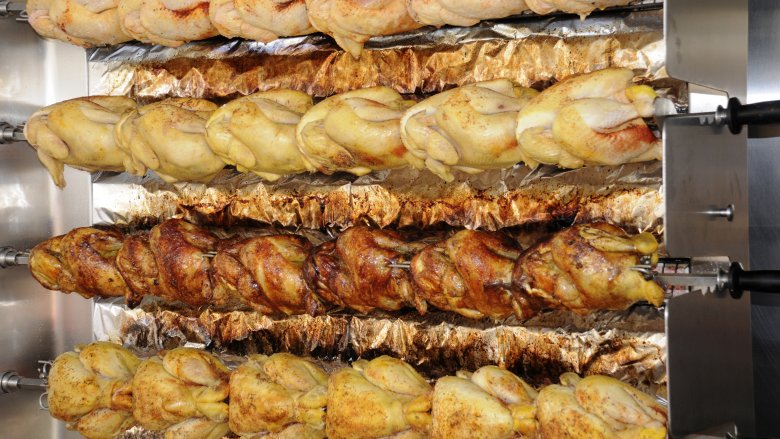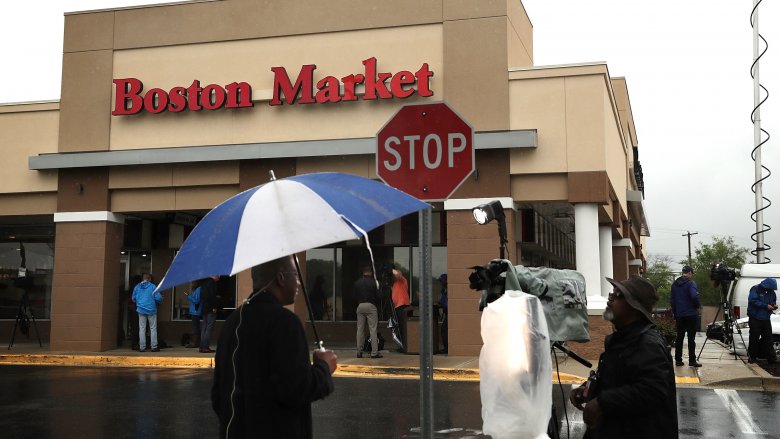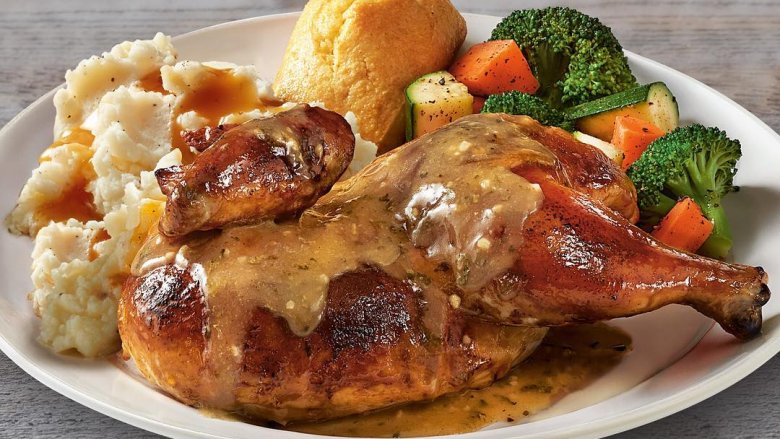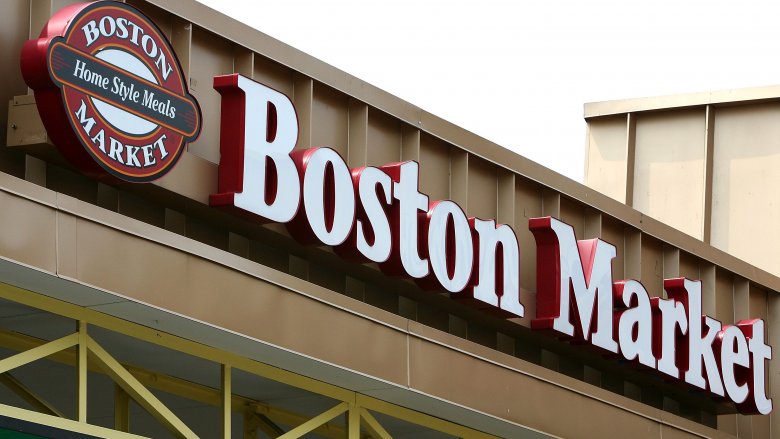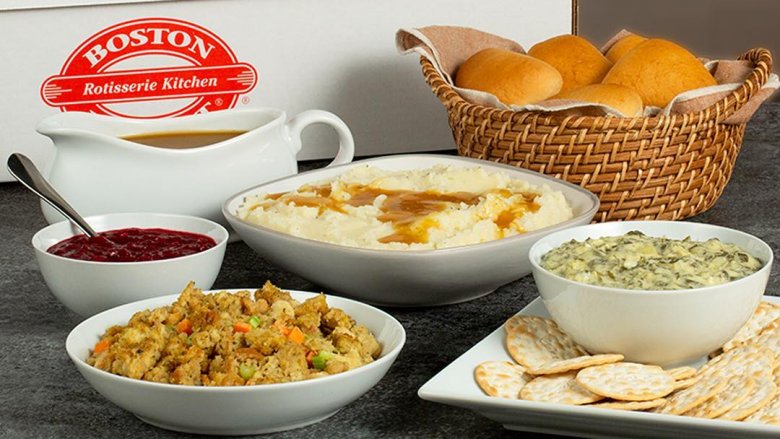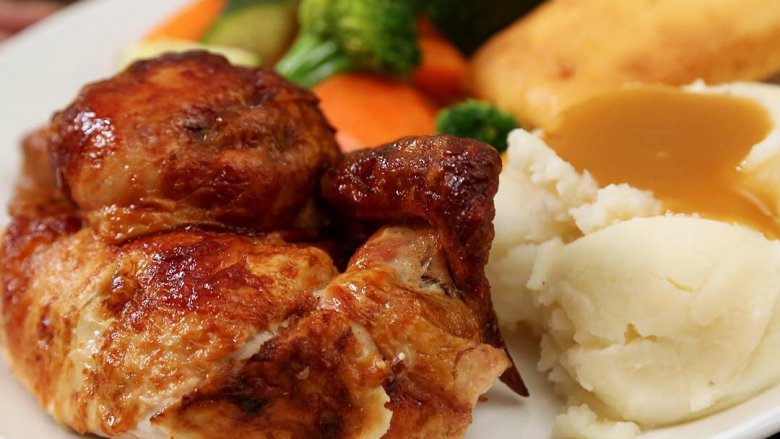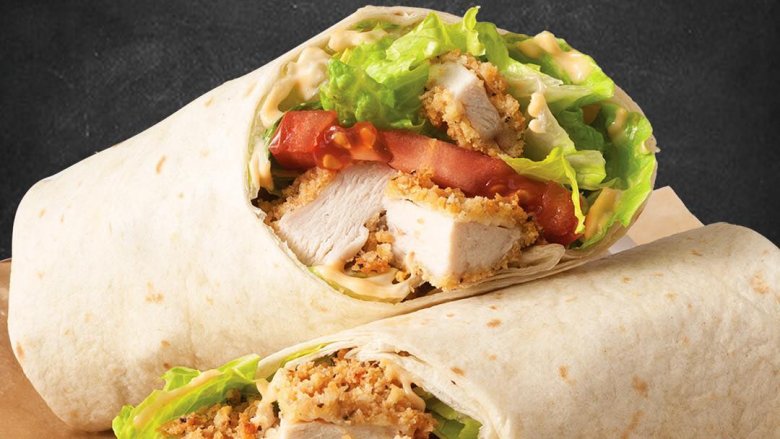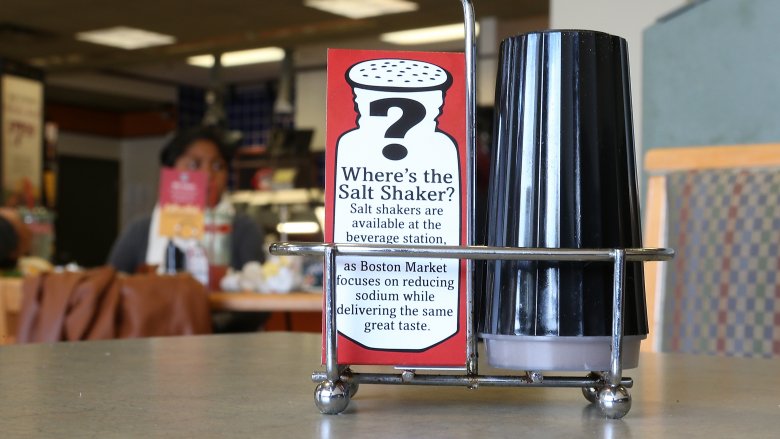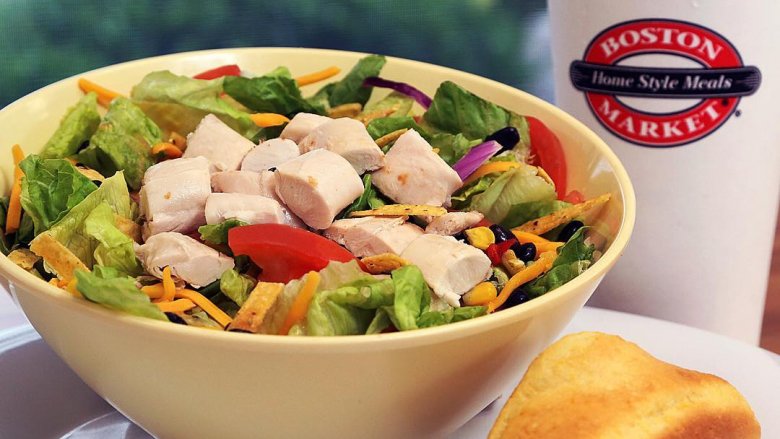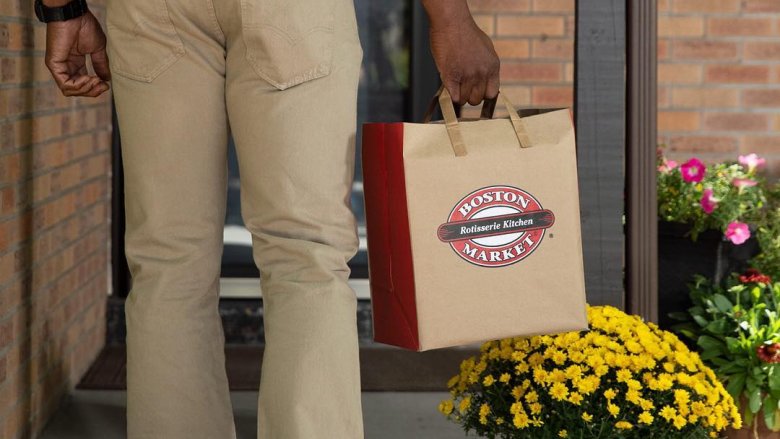The Real Reason Boston Market Is Disappearing
If you're like a lot of people, it's probably been a while since you've set foot in a Boston Market, the chain of quick service comfort food restaurants that once promised to free you from the shackles of evening family meal prep. The chain has shrunk by nearly 60 percent since its heyday in the early '90s, when there were over 1,100 locations spread across mini malls and shopping plazas nationwide.
While the chain may have fallen out of fashion in recent years, it was once the darling of Wall Street, offering investors insane returns on an IPO built on the backs of millions of herbed rotisserie chickens. Boston Market was poised to become the next major small chain success story, joining the ranks of restaurants like Chipotle and Panera Bread. In less than a decade, that dream would explode into a million pieces, leaving the chain facing bankruptcy, closing stores, and trying to put the pieces back together. What went wrong, and what sent this once-prominent chain scurrying into bankruptcy court? Let's take a look.
It expanded much too quickly
Boston Market attracted a lot of attention in the 1990s, thanks in part to its unusually aggressive expansion strategy. After a successful IPO in the early '90s (more on this later), the company rolled over the cash raised in the initial public stock offering to rapidly scale up the number of locations to about 1,200. Boston Market would loan the money to franchisees, who would in turn pay the company a franchise fee for each new store, royalties on food sales, and interest on the loans.
Boston Market reported this income as pure profit, leaving franchisees to bear the burden of traditional restaurant startup costs, which in turn drove the stock even higher, allowing the chain to open even more stores. Problems began to arise when all of these individual stores had to face the missteps common in many businesses; overpaying for product, discounting menu items excessively, or overpaying for real estate. Ultimately, Boston Market had difficulty managing the operations of each of these individual stores, and had to scale the number of locations back to about 460 stores nationwide.
Every supermarket on Earth now sells rotisserie chickens
In the early 1990s, the concept probably seemed pretty revolutionary: Instead of buying a raw chicken at the supermarket, bringing it home, dressing it, roasting it, sterilizing your kitchen to guard against salmonella, and carving the finished recipe yourself, what if you could pick up a whole rotisserie chicken large enough to feed an entire family, already cooked and ready to serve, with a complement of assorted side dishes, on your way home from a long day at the office?
The idea caught on quickly, and heads of household were quick to respond favorably to the convenience of a home-cooked meal, but without the time and expense of home cooking. The problem was that the concept was too easy to knock off; inside of a just a few years, every supermarket in the country installed rotisserie ovens, and began offering their own pre-roasted chickens, often at a fraction of the price of the same meal at Boston Market. Then-CEO George Michel put it simply to The Washington Post in 2015, saying, "Between 4:30 and 6:30, we compete with the supermarkets." For many customers, the ease of making one stop at the grocery store (where they could also grab other staples, such as a loaf of bread, toilet paper, or diapers) to buy a complete meal eclipsed the convenience offered at Boston Market.
A 1998 bankruptcy cut locations by two-thirds
The breakneck pace of Boston Market's location expansion in the early 1990s faced an abrupt course correction in 1998, when the company filed for bankruptcy protection. Following that restructuring of corporate debt, the chain closed nearly 700 locations; the number of Boston Market restaurants left standing today can be measured in the hundreds, not thousands.
Will the construction of newly christened Boston Market locations mark the next building boom in the quick service food market? Probably not. As Fortune reported in 2015, the chain had opened only four new locations in the two years prior, a philosophical departure from their earlier expansion strategy. Instead, the company would be focusing more on "average unit volume," which is a billionaire corporate board executive's way of saying, "We need the stores we already have to each make, like, way more money." Boston Market set an annual per-store sales goal of $1.5 million per unit, a difference of about half a million dollars more from what the company reported in 2010. And while we may have flunked out business school, we have to admit that strategy makes a lot more sense.
Previous marketing efforts focused on value instead of quality
Boston Market's previous marketing efforts may not have adequately connected potential consumers to the brand. Though the company reported spending about 60 percent of its total ad-buying budget on television ads, those ads haven't always resonated with customers.
Previous marketing initiatives have focused primarily on the value of a Boston Market meal, or touted the chain's limited time offerings. Now, the brand is shifting the focus of its marketing message to include more information about the quality of the food itself and how it is prepared, instead of squawking about the latest coupon deals. Of the new and improved ad campaign, then-CEO George Michel told Fortune, "It highlights in a bold way what sets Boston Market apart from our competitors. Fresh from the farm to our ovens, and then to our customers." In a nod to what drives the purchases of modern consumers, Boston Market is also working to highlight the low sodium content of some of its meals, as well as recommending meal combinations that total less than 500 calories.
Will this renewed focus on ingredients, quality, and healthy lifestyles help Boston Market to move the sales needle? Though the change in messaging feels like a step in the right direction, Boston Market will hardly be the only chain hanging their hats on the "farm freshness" of their product... we'll see if they can shout loudly enough over the marketing noise of their competitors.
Overhead was completely out of control
The food itself wasn't typically the problem at many Boston Market locations; consumers generally reacted favorably to the chain's signature combinations of rotisserie chicken, mashed potatoes, macaroni and cheese, cornbread, cinnamon apples, and steamed vegetables. But at many locations, store overhead — the parts of the restaurant's budget that you don't often think about, which includes things large and small, like rent and napkins — was excessively high.
In fact, everything at some Boston Market locations was expensive, from the high price of the real estate, to the expensive construction, to the software for the operating systems that ran the cash registers. If you could pay too much for something, Boston Market did it; even their food and disposable goods budget hovered at around 38 percent, which is at least 6 percent higher than industry norms. Richard Papiernik, financial editor of Nation's Restaurant News, told Entrepreneur, "In a restaurant industry professional roundtable we had, one of the people there was glad when Boston Market filed [for bankruptcy] because he said the restaurant real estate market might start to return to normal."
As Boston Market was overpaying at almost every turn, it meant that the volume of customers each location needed to keep out of the red was unusually high, and in many cases, unattainable.
Investors never saw returns after a sketchy IPO
Something was definitely amiss when Boston Market made its IPO, or initial public stock offering, and it took years for analysts to untangle the web of questionable accounting that briefly made Boston Market one of the early success stories of the pre-internet stock market age.
When the company went public in 1993 (operating then as "Boston Chicken"), the stock was priced at $20 per share. Within a day, the stock shot to about $49 per share, and would nearly double again by the end of 1996. Seems a little too good to be true for a chicken restaurant, doesn't it?
A 1999 article written by the New York Post seems to suggest that the stock's movement had little to do with any of the actual merits of the business, and was instead manipulated by insider trading and artificial stock price manipulation. There's another theory to explain the stock's astronomical success though — according to The Washington Post, the company's on-paper gains may have had more to do with some unusual accounting methods. Boston Market would report stock market gains as company profit, loan the money to franchisees (remember all those crazy-fast expansions?), and then add their royalty and franchise fees to the balance sheet without taking individual store sales into account. The result was that Boston Market looked insanely profitable, even as individual franchisees were suffering.
For all of the quick gains investors saw after the IPO, they were wiped out shortly thereafter when the company filed for bankruptcy less than five years later.
The menu hasn't caught up with consumer trends
While many customers may agree that the food at Boston Market is pretty darn good, with some even expressing slavish devotion to the chain's macaroni and cheese, it's not exactly cutting edge. Boston Market's whole business was built on the concept of "home cooking," the kinds of meals that you might have on a Sunday at your weird grandmother's house. And while this type of cooking might have a certain homey comfort, it's not typically what modern-day consumers are looking for when choosing a restaurant.
What do modern-day diners want? Multi-cultural offerings, including Korean, Filipino, and Persian flavors. Healthy, plant-based options, including meatless burgers and Yucca fries. Creative, over-the-top dipping sauces and glazes. According to QSR, these are the trends that will drive quick service consumer spending in 2019. With so many intensely flavorful, imaginative offerings exploding across the national dining landscape, it makes sense that "roast chicken and potatoes" hardly inspires the same excitement and social media frenzy as, say, an order of kimchi fries, topped with a four-cheese blend, spicy mayonnaise, Sriracha, caramelized kimchi, green and white onions, cilantro, and roasted sesame seeds.
Executives at Boston Market seem to have gotten the memo. According to then-CEO George Michel in a story by The Washington Post, customers were looking for "more fire in the food," which would explain the chain's addition of a sweet Thai chili garlic sauce and a honey habanero sauce to their menu.
The push to acquire lunch customers crippled the core concept
At its inception, the marketing team at Boston Market was quick to settle on a dining concept for the chain: "Home meal replacement," which the company predicted would become the new norm by which Americans would eat the majority of their dinnertime meals by the turn of the millennium.
But a major misstep in the mid-1990s would contribute to the decline of Boston Market: The introduction of sandwiches at lunchtime, which marked the chain's entry into the hyper-competitive fast food space. According to a spokesperson for Boston Market, in a conversation with The Washington Post, the company was "going down the wrong track." To push the lunch offerings, they blanketed the market with too many coupons which ending up undercutting profits, but that wasn't the only drawback — the chain's image of being the "home meal replacement" took a hit, too. As a result, Boston Market's lunch business actually grew, but their dinner business fell.
The lunch business at Boston Market hasn't gone away, and the company continues to focus on quick, grab-and-go items like sandwiches and pre-assembled meals to boost its midday numbers, but there's no doubt that the restaurant's core concept suffered as a result.
They're pretty low on atmosphere
When you're considering a romantic night out, or even trying to imagine a place where you can bring the family without the kids getting vinyl booth-burn on the backs of their thighs, Boston Market probably doesn't spring immediately to mind. Even if you love the food, the atmosphere at Boston Market isn't exactly crackling with appetite-stimulating energy. Sure, most of the construction feels pretty high end, and even the oldest locations don't necessarily feel run down, but there's something about that long single line and the buffet style ordering that makes the whole experience feel like dining at an off-brand budget casino.
The problem is, customers nowadays are looking for that careful balance between convenience and experience; in other words, they want to be able to quickly place an order and get back to what they were doing, but sometimes they also want to lounge around in a pleasant environment. Boston Market seems to be having trouble striking this careful balance.
Marketing missteps have left a bad taste in customers' mouths
Okay, so you can't totally blame Boston Market for this one; they're just another company that radically underestimated the raw purchasing power of this newfangled "Internet" thing, even as the stuffed shirts in the marketing department were trying to get their heads around what "a global network of networks" could possibly mean. (Oh, to have been a fly on the wall at some of those early dot-com strategy meetings: "See, we're gonna spend $6 million on a Superbowl ad where this sock monkey tells people to buy 50-pound bags of dog food on the Information Superhighway!")
So when Boston Market tried an old-school marketing approach — a coupon that afforded its owner a chicken meal for just a buck — they maybe hadn't considered what would happen once it met the wide distribution of the Internet. Spoiler alert: chaos ensued. According to AOL, so many people tried to cash in their deeply discounted chicken coupons at the same time that many locations couldn't keep up with demand. One restaurant in Florida posted handwritten signs in the window pleading with customers to only cash in one coupon at a time, and many customers were turned away without receiving their meals.
Unfortunately for the company, this is the kind of misstep that consumers tend to remember.
Even the marketing muscle at McDonald's couldn't figure out what to do with the chain
Things really seemed to be looking up for the struggling Boston Market empire in the year 2000, when megachain McDonald's swooped in and acquired the company out of bankruptcy. Expectations were high; in a press release at the time, an executive at Boston Market said, "We're pleased that the court has now cleared the way for Boston Market to emerge from bankruptcy and become part of the world's largest foodservice company. ... With the benefit of McDonald's resources and expertise, we'll now be able to provide our customers with an even better restaurant experience — and our employees with great new growth opportunities." The expectation, obviously, was that if anyone could turn the challenged company around, it would be the McDonald's corporation, who operates one of the largest fast food chains in the world.
Did they pull it off? Well, yes and no. Though sales began to rebound thanks to the oversight of the McDonald's executive team, they company also guided Boston Market into some peculiar arenas, including the sales of some dishes as frozen food items in supermarkets, which seemed like a bit of a contradiction of the company's original concept. By 2007, McDonald's had helped stopped the hemorrhaging and stabilized the company at around 500 locations, before politely ducking out in a quick sale to Sun Capital Partners. This would seem to suggest that while McDonald's may have been happy to help the company turn its finances around in the short term, it wasn't anxious to stick around for the long haul.
